Techno-Economic Analysis of Combined Gas and Steam Propulsion System of Liquefied Natural Gas Carrier
Abstract
1. Introduction
2. Research Methodology
2.1. Design Data of the LNG Carrier
2.2. Design of COGES Propulsion System
2.3. Thermodynamic Analysis of Designed System
2.4. Environmental Impact Assessment
2.5. Techno-Economic Analysis
3. Results and Discussion
3.1. Performance of COGES System
3.2. Analysis of the Environmental Impact of the System
3.3. Economic Feasibility of COGES System
4. Conclusions
Author Contributions
Funding
Data Availability Statement
Acknowledgments
Conflicts of Interest
References
- International Maritime Organization (IMO). Initial Imo Strategy on Reduction of Ghg Emissions from Ships; International Maritime Organization (IMO): London, UK, 2018. [Google Scholar]
- Joung, T.-H.; Kang, S.-G.; Lee, J.-K.; Ahn, J. The IMO initial strategy for reducing Greenhouse Gas (GHG) emissions, and its follow-up actions towards 2050. J. Int. Marit. Safety Environ. Aff. Shipp. 2020, 4, 1–7. [Google Scholar] [CrossRef]
- Mallouppas, G.; Yfantis, E.A. Decarbonization in Shipping Industry: A Review of Research, Technology Development, and Innovation Proposals. J. Mar. Sci. Eng. 2021, 9, 415. [Google Scholar] [CrossRef]
- Nuchturee, C.; Li, T.; Xia, H. Energy efficiency of integrated electric propulsion for ships—A review. Renew. Sustain. Energy Rev. 2020, 134, 110145. [Google Scholar] [CrossRef]
- Dotto, A.; Campora, U.; Satta, F. Feasibility study of an integrated COGES-DF engine power plant in LNG propulsion for a cruise-ferry. Energy Convers. Manag. 2021, 245, 114602. [Google Scholar] [CrossRef]
- Merz, C.A.; Pakula, T.J. The Design and Operational Characteristics of a Combined Cycle Marine Powerplant. In Proceedings of the ASME Turbo Expo, Montreal, QC, Canada, 15–19 June 2015. [Google Scholar]
- Haglind, F. A review on the use of gas and steam turbine combined cycles as prime movers for large ships. Part II: Previous work and implications. Energy Convers. Manag. 2008, 49, 3468–3475. [Google Scholar] [CrossRef]
- Packalén, S.; Karlsson Nord, N. Combined Gas- and Steam Turbine as Prime Mover in Marine Applications; Department of Shipping and Marine Technology, Chalmers University of Technology: Gothenburg, Sweden, 2017. [Google Scholar]
- Alzayedi, A.M.T.; Sampath, S.; Pilidis, P. Techno-Environmental Evaluation of a Liquefied Natural Gas-Fuelled Combined Gas Turbine with Steam Cycles for Large Container Ship Propulsion Systems. Energies 2022, 15, 1764. [Google Scholar] [CrossRef]
- Pereira, S.; Almeida, P. Energy Assessment and Comparison of the Use of a Conventional Steam Turbine System in a Lng Carrier Propulsion with the Use of a Coges System. SSRN Electron. J. 2022. [Google Scholar] [CrossRef]
- LNGreen: Next-Generation LNG Carrier Concept by DNV GL, HHI, GTT and GasLog n.d. Available online: https://www.dnv.com/news/lngreen-next-generation-lng-carrier-concept-by-dnv-gl-hhi-gtt-and-gaslog-30420 (accessed on 6 December 2023).
- Pamitran, A.S.; Budiyanto, M.A.; Dandy Yusuf Maynardi, R. Analysis of ISO-tank wall physical exergy characteristic—Case study of LNG boil-off rate from retrofitted dual fuel engine conversion. Evergreen 2019, 6, 134–142. [Google Scholar] [CrossRef]
- Al-Kubaisi, A. An Insight into the World’s Largest LNG Ships. In Proceedings of the International Petroleum Technology Conference, Kuala Lumpur, Malaysia, 3–5 December 2008. [Google Scholar] [CrossRef]
- Wibisana, L.P.; Budiyanto, M.A. Design and Cost Multi-Objective Optimization of Small-Scale LNG Carriers using the Value Engineering Approach. Int. J. Technol. 2021, 12, 1288–1301. [Google Scholar] [CrossRef]
- Budiyanto, M.A.; Singgih, I.K.; Riadi, A.; Putra, G.L. Study on the LNG distribution to Mobile Power Plants using a Small-Scale LNG Carrier for the case of the Sulawesi region of Indonesia. Energy Rep. 2022, 8, 374–380. [Google Scholar] [CrossRef]
- Yin, L.; Ju, Y. Review on the design and optimization of BOG re-liquefaction process in LNG ship. Energy 2022, 244, 123065. [Google Scholar] [CrossRef]
- Qu, Y.; Noba, I.; Xu, X.; Privat, R.; Jaubert, J.-N. A thermal and thermodynamic code for the computation of Boil-Off Gas—Industrial applications of LNG carrier. Cryogenics 2019, 99, 105–113. [Google Scholar] [CrossRef]
- Ferrín, J.L.; Pérez-Pérez, L.J. Numerical simulation of natural convection and boil-off in a small size pressurized LNG storage tank. Comput. Chem. Eng. 2020, 138, 106840. [Google Scholar] [CrossRef]
- Gerasimov, V.E.; Kuz’Menko, I.F.; Peredel’Skii, V.A.; Darbinyan, R.V. Introduction of technologies and equipment for production, storage, transportation, and use of LNG. Chem. Pet. Eng. 2004, 40, 31–35. [Google Scholar] [CrossRef]
- Budiyanto, M.A.; Riadi, A.; Buana, I.G.N.S.; Kurnia, G. Study on the LNG distribution to mobile power plants utilizing small-scale LNG carriers. Heliyon 2020, 6, e04538. [Google Scholar] [CrossRef] [PubMed]
- APEC. Study on Optimal Use of Small-Scale Shallow-Draft LNG Carriers and FSRUs in the APEC Region APEC Energy Working Group. 2020. Available online: https://www.apec.org/docs/default-source/publications/2020/4/study-on-optimal-use-of-small-scale-shallow-draft-lng-carriers-and-fsrus-in-the-apec-region/220_ewg_study-on-optimal-use-of-small-scale-shallow-draft-lng-carriers-and-fsrus-in-the-apec-region.pdf (accessed on 21 December 2023).
- Budiyanto, M.A.; Pamitran, A.S.; Yusman, T. Optimization of the Route of Distribution of LNG using Small Scale LNG Carrier: A Case Study of a Gas Power Plant in the Sumatra Region, Indonesia. Int. J. Energy Econ. Policy 2019, 9, 179–187. [Google Scholar] [CrossRef]
- Hongjun, F.; Lei, W.; Bo, Z.; Enshaei, H.; Jiaolong, C. A study on design optimization of LNG power system onboard a dual fueled platform supply vessel. In Proceedings of the 2nd International Conference on Smart & Green Technology for Shipping and Maritime Industries, Glasgow, Scotland, 11–12 July 2019; Available online: https://hdl.handle.net/102.100.100/522683 (accessed on 21 December 2023).
- Boretti, A. Advantages and Disadvantages of Diesel Single and Dual-Fuel Engines. Front. Mech. Eng. 2019, 5, 493925. [Google Scholar] [CrossRef]
- Budiyanto, M.A.; Nasruddin; Nawara, R. The optimization of exergoenvironmental factors in the combined gas turbine cycle and carbon dioxide cascade to generate power in LNG tanker ship. Energy Convers. Manag. 2020, 205, 112468. [Google Scholar] [CrossRef]
- Cwilewicz, R.; Górski, Z. Prognosis of marine propulsion plants development in view of new requirements concerning marine fuels. J. Kones 2014, 21, 61–68. [Google Scholar] [CrossRef]
- Dotto, A.; Sacchi, R.; Satta, F.; Campora, U. Dynamic performance simulation of combined gas electric and steam power plants for cruise-ferry ships. Next Energy 2023, 1, 100020. [Google Scholar] [CrossRef]
- Fernández, I.A.; Gómez, M.R.; Gómez, J.R.; Insua, B. Review of propulsion systems on LNG carriers. Renew. Sustain. Energy Rev. 2017, 67, 1395–1411. [Google Scholar] [CrossRef]
- Tadros, M.; Ventura, M.; Guedes Soares, C. A nonlinear optimization tool to simulate a marine propulsion system for ship conceptual design. Ocean Eng. 2020, 210, 107417. [Google Scholar] [CrossRef]
- Inal, O.B.; Charpentier, J.F.; Deniz, C. Hybrid power and propulsion systems for ships: Current status and future challenges. Renew. Sustain. Energy Rev. 2021, 156, 111965. [Google Scholar] [CrossRef]
- Kurz, R. Parameter Optimization on Combined Gas Turbine-Fuel Cell Power Plants. J. Fuel Cell Sci. Technol. 2005, 2, 268–273. [Google Scholar] [CrossRef]
- Sulligoi, G.; Vicenzutti, A.; Menis, R. All-electric ship design: From electrical propulsion to integrated electrical and electronic power systems. IEEE Trans. Transp. Electrif. 2016, 2, 507–521. [Google Scholar] [CrossRef]
- Pamik, M.; Nuran, M. The historical process of the diesel electric propulsion system. Dokuz Eylül Üniversitesi Denizcilik Fakültesi Derg. 2021, 13, 299–316. [Google Scholar] [CrossRef]
- Ahmadi, G.; Jahangiri, A.; Toghraie, D. Design of heat recovery steam generator (HRSG) and selection of gas turbine based on energy, exergy, exergoeconomic, and exergo-environmental prospects. Process. Saf. Environ. Prot. 2023, 172, 353–368. [Google Scholar] [CrossRef]
- Nirbito, W.; Budiyanto, M.A.; Muliadi, R. Performance Analysis of Combined Cycle with Air Breathing Derivative Gas Turbine, Heat Recovery Steam Generator, and Steam Turbine as LNG Tanker Main Engine Propulsion System. J. Mar. Sci. Eng. 2020, 8, 726. [Google Scholar] [CrossRef]
- Huan, T.; Hongjun, F.; Wei, L.; Guoqiang, Z. Options and Evaluations on Propulsion Systems of LNG Carriers. In Propulsion Systems; IntechOpen: London, UK, 2019. [Google Scholar] [CrossRef]
- Lombardi, L.; Carnevale, E.; Corti, A. A review of technologies and performances of thermal treatment systems for energy recovery from waste. Waste Manag. 2015, 37, 26–44. [Google Scholar] [CrossRef] [PubMed]
- Singh, D.V.; Pedersen, E. A review of waste heat recovery technologies for maritime applications. Energy Convers. Manag. 2016, 111, 315–328. [Google Scholar] [CrossRef]
- Díaz-Secades, L.A.; González, R.; Rivera, N.; Montañés, E.; Quevedo, J.R. Waste heat recovery system for marine engines optimized through a preference learning rank function embedded into a Bayesian optimizer. Ocean Eng. 2023, 281, 114747. [Google Scholar] [CrossRef]
- Larsen, U.; Sigthorsson, O.; Haglind, F. A comparison of advanced heat recovery power cycles in a combined cycle for large ships. Energy 2014, 74, 260–268. [Google Scholar] [CrossRef]
- Ouyang, T.; Zhao, Z.; Lu, J.; Su, Z.; Li, J.; Huang, H. Waste heat cascade utilisation of solid oxide fuel cell for marine applications. J. Clean. Prod. 2020, 275, 124133. [Google Scholar] [CrossRef]
- Theotokatos, G.; Livanos, G. Techno-economical analysis of single pressure exhaust gas waste heat recovery systems in marine propulsion plants. Proc. Inst. Mech. Eng. Part M J. Eng. Marit. Environ. 2012, 227, 83–97. [Google Scholar] [CrossRef]
- Buonomano, A.; Del Papa, G.; Francesco Giuzio, G.; Maka, R.; Palombo, A. Advancing sustainability in the maritime sector: Energy design and optimization of large ships through information modelling and dynamic simulation. Appl. Therm. Eng. 2023, 235, 121359. [Google Scholar] [CrossRef]
- Çolak, K.; Ölmez, H.; Saraç, B. Waste heat recovery assessment of triple heat-exchanger usage for ship main engine pre-heating and fresh water generation systems. Proc. Inst. Mech. Eng. Part M J. Eng. Marit. Environ. 2023, 238, 209–230. [Google Scholar] [CrossRef]
- Benvenuto, G.; Trucco, A.; Campora, U. Optimization of waste heat recovery from the exhaust gas of marine diesel engines. Proc. Inst. Mech. Eng. Part M J. Eng. Marit. Environ. 2014, 230, 83–94. [Google Scholar] [CrossRef]
- Altosole, M.; Benvenuto, G.; Campora, U.; Laviola, M.; Trucco, A. Waste Heat Recovery from Marine Gas Turbines and Diesel Engines. Energies 2017, 10, 718. [Google Scholar] [CrossRef]
- Saidur, R.; Rezaei, M.; Muzammil, W.K.; Hassan, M.H.; Paria, S.; Hasanuzzaman, M. Technologies to recover exhaust heat from internal combustion engines. Renew. Sustain. Energy Rev. 2012, 16, 5649–5659. [Google Scholar] [CrossRef]
- Farhat, O.; Faraj, J.; Hachem, F.; Castelain, C.; Khaled, M. A recent review on waste heat recovery methodologies and applications: Comprehensive review, critical analysis and potential recommendations. Clean. Eng. Technol. 2022, 6, 100387. [Google Scholar] [CrossRef]
- Asimptote. Cycle-Tempo. n.d. Available online: https://asimptote.com/cycle-tempo/ (accessed on 31 January 2023).
- Japan International Cooperation Agency. Financial and Economical Analysis of New Power Plant. 2019. Available online: https://openjicareport.jica.go.jp/pdf/12119806_01.pdf (accessed on 21 December 2023).
- Japan International Cooperation Agency (JICA). Cost Estimation of the New Power Plant for Construction and Operation. 2004. Available online: https://openjicareport.jica.go.jp/pdf/11750742_19.pdf (accessed on 21 December 2023).
- Global LNG Shipping—ORders and Deliveries Report|Wood Mackenzie. n.d. Available online: https://www.woodmac.com/reports/lng-global-lng-shipping-orders-and-deliveries-58425985/ (accessed on 21 December 2023).
- LNG Tanker Average Spot Charter Rate 2021|Statista n.d. Available online: https://www.statista.com/statistics/1112660/lng-tanker-average-spot-charter-rate/ (accessed on 21 December 2023).
- Poullikkas, A. An overview of current and future sustainable gas turbine technologies. Renew. Sustain. Energy Rev. 2005, 9, 409–443. [Google Scholar] [CrossRef]
- Banihabib, R.; Assadi, M. The Role of Micro Gas Turbines in Energy Transition. Energies 2022, 15, 8084. [Google Scholar] [CrossRef]
- Harperscheidt, J. LNG as Fuel-Bunkering, Storage and Processing. 2003. Available online: https://www.stg-online.org/onTEAM/shipefficiency/programm/12-Harperscheidt_TGE.pdf (accessed on 21 December 2023).
- Kim, K.; Park, K.; Roh, G.; Chun, K. Case Study on Boil-Off Gas (BOG) Minimization for LNG Bunkering Vessel Using Energy Storage System (ESS). J. Mar. Sci. Eng. 2019, 7, 130. [Google Scholar] [CrossRef]
- Budiyanto, M.A.; Zidane, S.A.; Putra, G.L.; Riadi, A.; Andika, R.; Theotokatos, G. Performance Analysis of Combined Gas-Electric Steam Turbine System as Main Propulsion for Small-scale LNG Carrier Ships. Int. J. Technol. 2023, 14, 1093–1102. [Google Scholar] [CrossRef]
- Davidson, A.; Wait, N.; Desouza, C.; Marsh, D.; Green, D.; Andrews, P.; Chapman, S. Clean Air Gas Engine (CAGE): Reducing emissions by replacing diesel power in construction. High Speed Two (HS2) Infrastruct. Des. Constr. 2023, 4, 229–235. [Google Scholar] [CrossRef]
- Balcombe, P.; Heggo, D.A.; Harrison, M. Total Methane and CO2 Emissions from Liquefied Natural Gas Carrier Ships: The First Primary Measurements. Environ. Sci. Technol. 2022, 56, 9632–9640. [Google Scholar] [CrossRef]



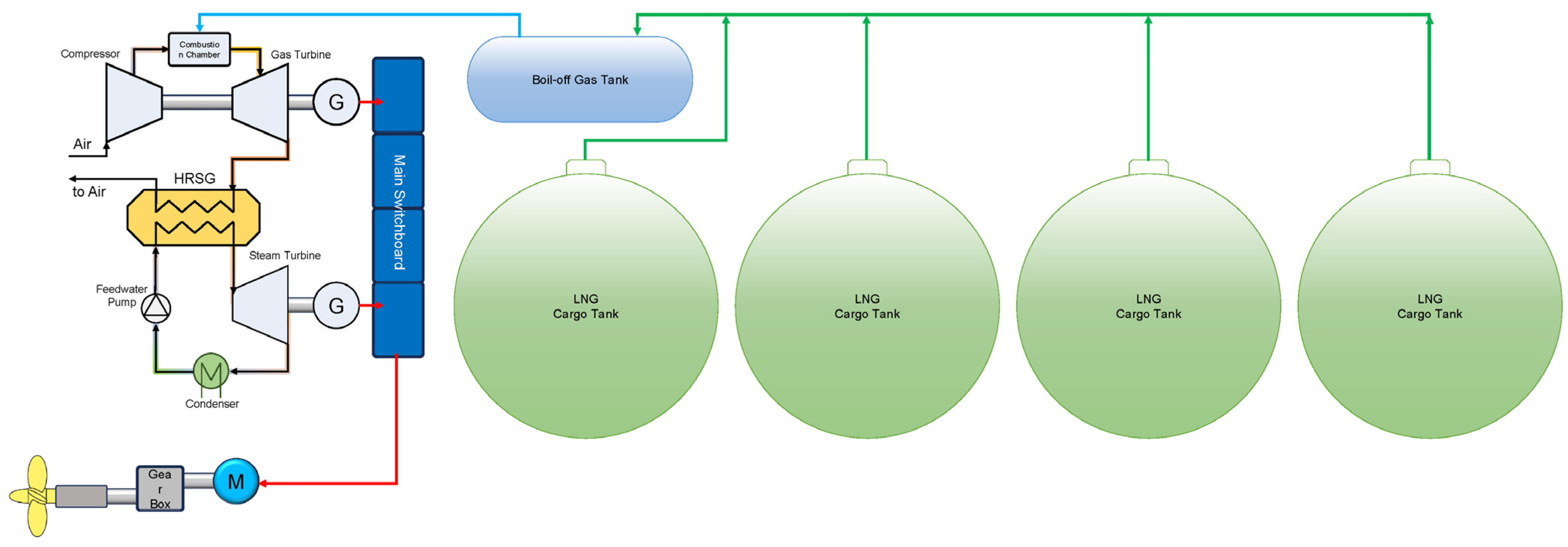
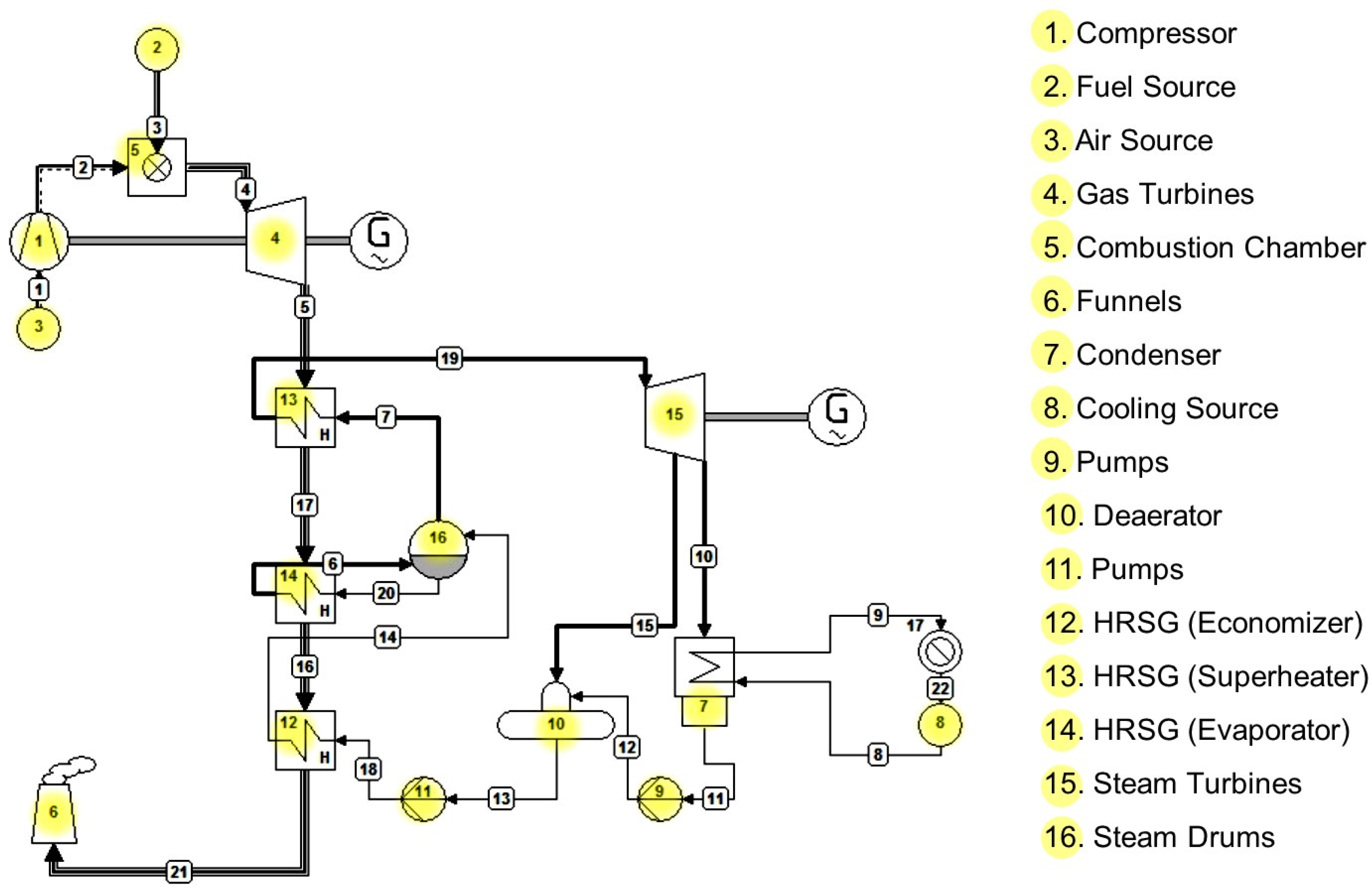

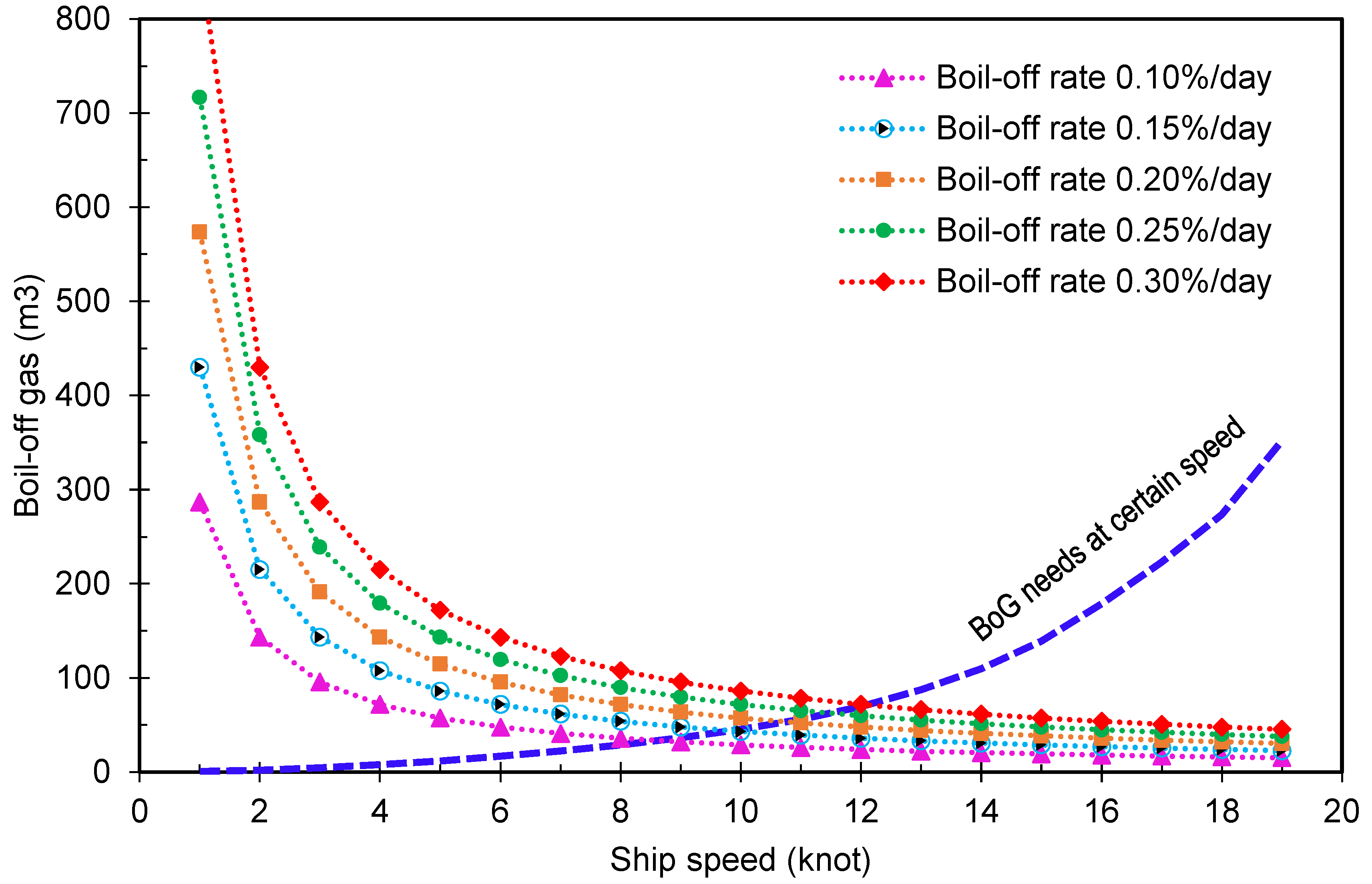
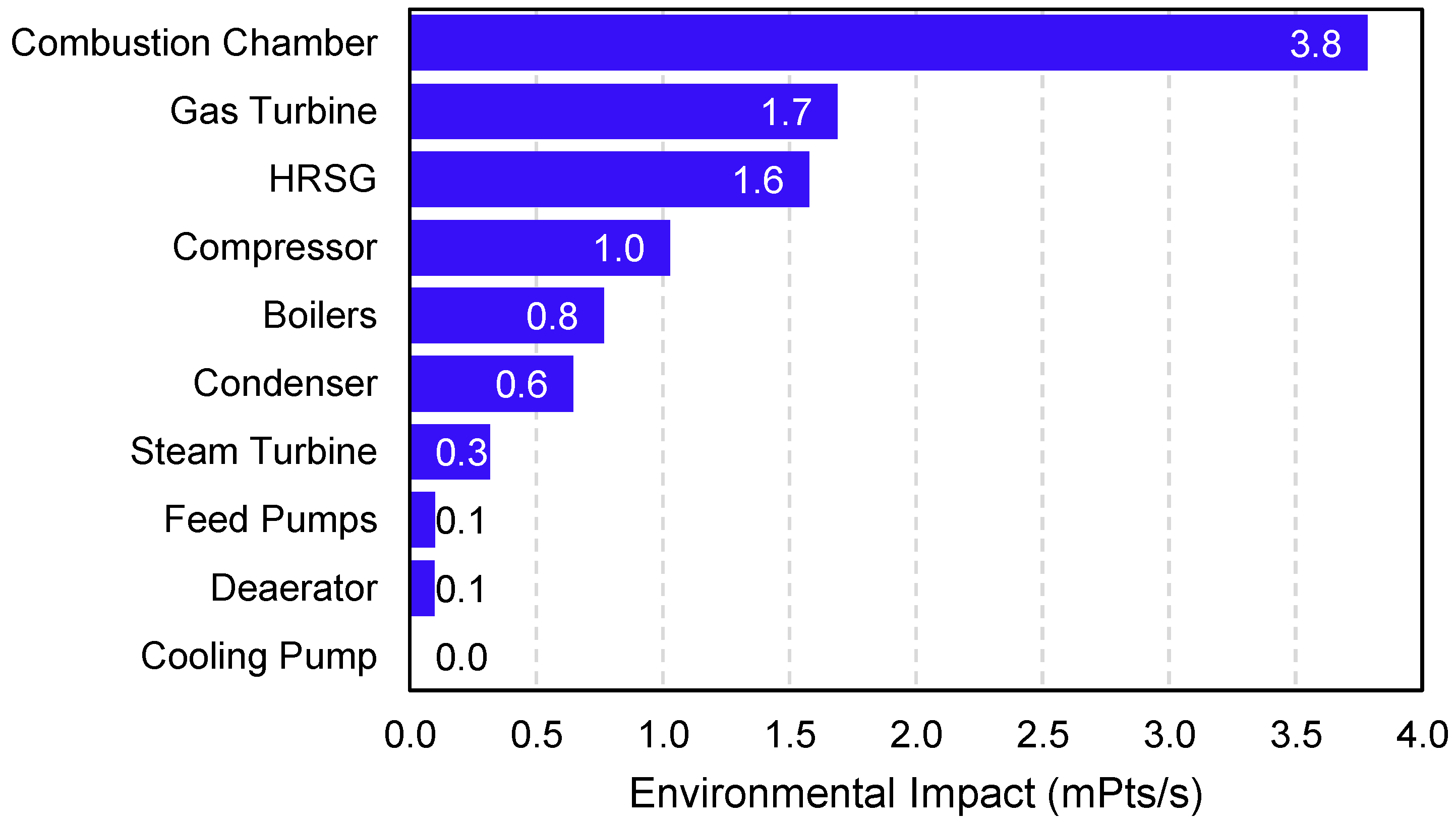
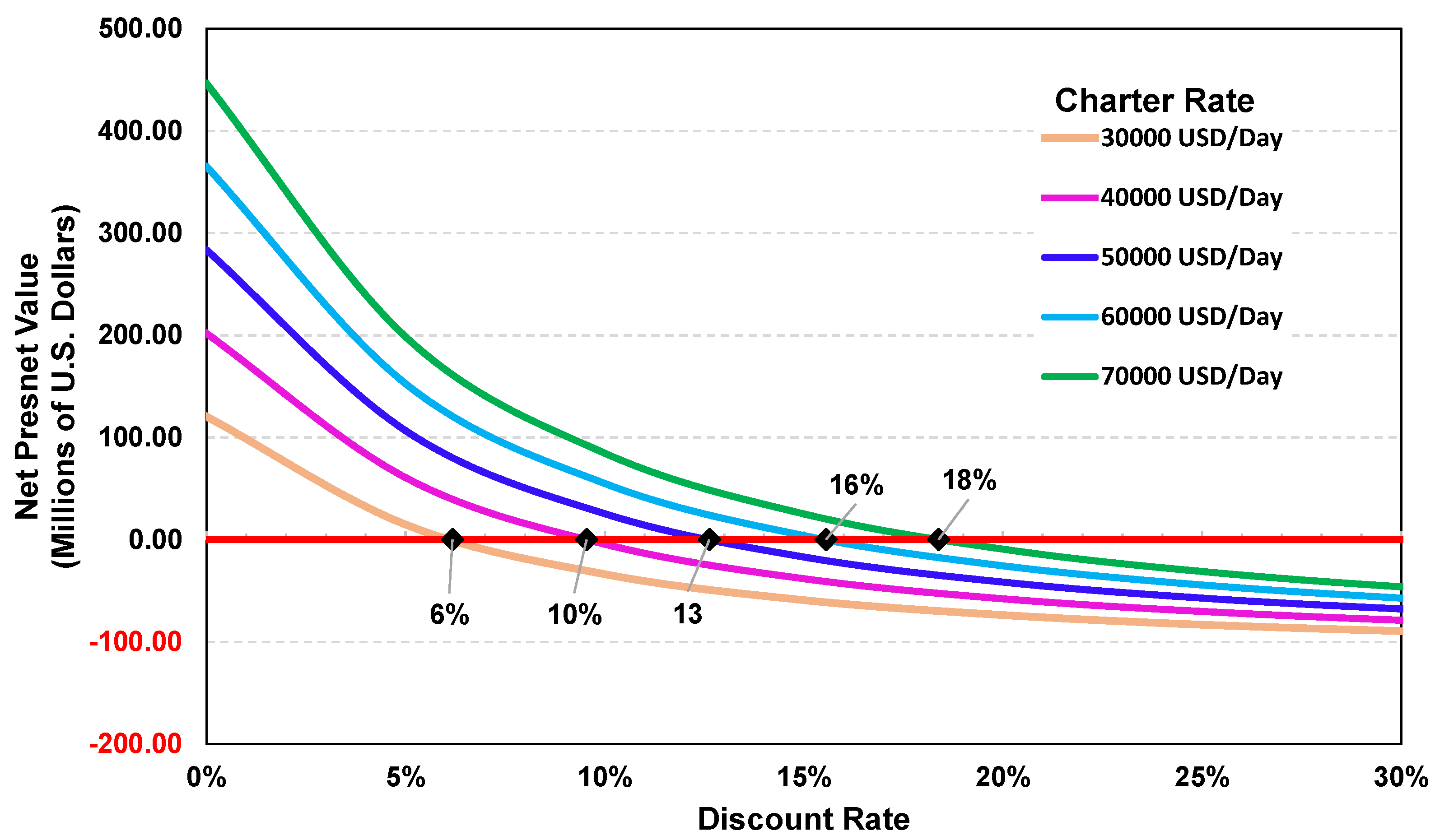
| Principal Parameters | Dimensions |
|---|---|
| Length overall | : 117.8 m |
| Length between perpendicular | : 110.2 m |
| Beam | : 18.6 m |
| Depth | : 10.6 m |
| Draft | : 7.15 m |
| Service speed | : 12 knots |
| Cargo tank capacity | : 7500 m3 |
| Boil-off gas rate | : 0.3%/day |
| Crew number | : 19 |
| Cycle | Parameter Input | Thermodynamic Equations |
|---|---|---|
| Ambient | T = 298 K P = 1.013 bar | |
| Gas Turbine Cycle 1g—Compression | T = 298 K P = 1.013 bar mair = 21.3 kg/s mfuel = 0.512 kg/s | T = = 647 K Wcompressor = |
| Gas Turbine Cycle 2g—Combustion | P = 11.92 bar h = 374 kJ/kg | |
| Gas Turbine Cycle 3g—Expansion | P = 11.92 bar | T = = 1373 K |
| Gas Turbine Cycle 4g—Heat Rejection | T = 767 K P = 1.013 bar | Wgas turbine = Wactual = Wgas turbine − Wcompressor |
| Steam Turbine Cycle 1s—Water Feeding | T = 297 K h = 100.5 kJ/kg P = 1.0 bar | Wpump = |
| Steam Turbine Cycle 2s—Pump Work Input | T = 302 K h = 125.74 kJ/kg mexhaust = 21.812 kg/s | |
| Steam Turbine Cycle 3s—Heat Addition | T = 558 K h = 1263.1 kJ/kg P = 80 bar | Qexhaust = Qin, rankine mexhaust. Cp. = mfluid (h4 − h3) |
| Steam Turbine Cycle 4s—Heat Addition | T = 568 K h = 2758.7 kJ/kg | |
| Steam Turbine Cycle 5s—Work Output | T = 834 K h = 3384 kJ/kg | Wactual = Wgas turbine − Wcompressor Wturbine = mfluid (h5 − h6) − Wpump |
| Steam Turbine Cycle 6s—Heat Rejection | T = 302 K h = 2555.6 kJ/kg |
| Component | Estimated Cost | Reference |
|---|---|---|
| Gas Turbine | USD 55,000,000.00 | [51] |
| Steam Turbine | USD 18,000,000.00 | [51] |
| HRSG | USD 26,000,000.00 | [51] |
| Generator | USD 15,000,000.00 | [51] |
| Hot Water Supply System | USD 7,000,000.00 | [51] |
| Condenser | USD 80,000.00 | [51] |
| Deaerator | USD 800,000.00 | [51] |
| Cooling Pump | USD 8000.00 | [51] |
| Component | Power (kW) |
|---|---|
| Gas turbine air compressor | 7359.36 |
| Gas turbine | 13,085.89 |
| Actual gas turbine | 5726.53 |
| Pump | 2.82 |
| Steam turbine | 2645.52 |
| Actual steam turbine | 2642.70 |
| Total Combined Gas and Steam | 8369.23 |
| Component | Eco-Indicator (Pts) | |||
|---|---|---|---|---|
| Ecosystem | Health | Source | Total | |
| Compressor | 0.326 | 10.5 | 386 | 396.8 |
| Combustion Chamber | 1.2 | 38.9 | 1420 | 1460.1 |
| Turbin Gas | 0.535 | 17.3 | 634 | 651.8 |
| HRSG | 0.5 | 16.2 | 592 | 608.7 |
| Turbin Steam | 0.101 | 3.26 | 119 | 122.4 |
| Boiler | 0.243 | 7.86 | 288 | 296.1 |
| Deaerator | 0.0307 | 0.993 | 36.4 | 37.4 |
| Feed Pump | 0.0316 | 1.02 | 37.4 | 38.4 |
| Condenser | 0.204 | 6.61 | 242 | 248.8 |
| Cooling Pump | 0.0013 | 0.043 | 1.58 | 1.62 |
| Category | Unit | COGES | Diesel | DFDE |
|---|---|---|---|---|
| Climate Change | kgCO2 equivalents | 0.149 | 0.314 | 0.155 |
| Human Health | DALY | 0.755 × 10−7 | 4.61 × 10−7 | 1.64 × 10−7 |
| Ecosystem Quality | PDFm2yr | 0.00102 | 0.0153 | 0.00514 |
| Resource | MJ surplus | 2.06 | 4.09 | 2.744 |
| Charter Rate | Net Present Value (NPV) | Internal Rate Return (IRR) | Payback Period (PBP) |
|---|---|---|---|
| 30,000 USD/Day | USD 33,845,188.90 | 6.18% | 13 Years |
| 40,000 USD/Day | USD 4,057,766.87 | 9.54% | 10 Years |
| 50,000 USD/Day | USD 25,585,478.17 | 12.63% | 8 Years |
| 60,000 USD/Day | USD 55,228,723.22 | 15.55% | 7 Years |
| 70,000 USD/Day | USD 84,871,968.26 | 18.38% | 6 Years |
Disclaimer/Publisher’s Note: The statements, opinions and data contained in all publications are solely those of the individual author(s) and contributor(s) and not of MDPI and/or the editor(s). MDPI and/or the editor(s) disclaim responsibility for any injury to people or property resulting from any ideas, methods, instructions or products referred to in the content. |
© 2024 by the authors. Licensee MDPI, Basel, Switzerland. This article is an open access article distributed under the terms and conditions of the Creative Commons Attribution (CC BY) license (https://creativecommons.org/licenses/by/4.0/).
Share and Cite
Budiyanto, M.A.; Putra, G.L.; Riadi, A.; Andika, R.; Zidane, S.A.; Muhammad, A.H.; Theotokatos, G. Techno-Economic Analysis of Combined Gas and Steam Propulsion System of Liquefied Natural Gas Carrier. Energies 2024, 17, 1415. https://doi.org/10.3390/en17061415
Budiyanto MA, Putra GL, Riadi A, Andika R, Zidane SA, Muhammad AH, Theotokatos G. Techno-Economic Analysis of Combined Gas and Steam Propulsion System of Liquefied Natural Gas Carrier. Energies. 2024; 17(6):1415. https://doi.org/10.3390/en17061415
Chicago/Turabian StyleBudiyanto, Muhammad Arif, Gerry Liston Putra, Achmad Riadi, Riezqa Andika, Sultan Alif Zidane, Andi Haris Muhammad, and Gerasimos Theotokatos. 2024. "Techno-Economic Analysis of Combined Gas and Steam Propulsion System of Liquefied Natural Gas Carrier" Energies 17, no. 6: 1415. https://doi.org/10.3390/en17061415
APA StyleBudiyanto, M. A., Putra, G. L., Riadi, A., Andika, R., Zidane, S. A., Muhammad, A. H., & Theotokatos, G. (2024). Techno-Economic Analysis of Combined Gas and Steam Propulsion System of Liquefied Natural Gas Carrier. Energies, 17(6), 1415. https://doi.org/10.3390/en17061415









